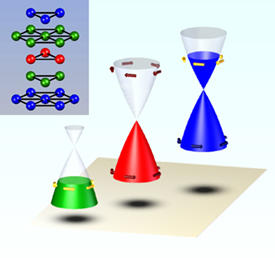

05/28/2012

Topological insulators exhibit some of the most fascinating conductive properties of any material. Although the bulk volume of a topological insulator does not pass any current, its surface is highly conductive and the magnetic spin orientations of the surface currents are relatively easy to preserve. This unique behavior has stimulated studies into both the fundamental science behind these properties and applications such as ultralow-power spin transistors. Toshiyuki Arakane, Takashi Takahashi and colleagues at Tohoku University and Osaka University have now developed a topological insulator material that should aid research in this area1.
The researchers focused on an outstanding problem in the field: the bulk of a topological insulator often has defects through which current can flow. This bulk current can obscure surface currents whose behavior is the intended subject of the experiment. Previous work by other researchers showed that manipulating the elemental composition of a topological insulator can reduce its bulk conductivity while maintaining high surface conductivity.
Arakane and co-workers took this work a step further by showing that manipulating the composition of a topological insulator can keep its bulk conductivity low while also allowing the surface current to be tuned between positive and negative charge carriers. They chose to investigate BSTS — a material made from bismuth, antimony, tellurium and selenium (see image). BSTS is known to have two types of crystal defects: one that contributes positive charge carriers, and one that contributes negative charge carriers. Careful control over the relative amount of each element allowed the researchers to balance these defects, thus minimizing the bulk conductivity.
Through angle-resolved photoemission spectroscopy, the researchers revealed that this compositional control can also be used to adjust the energy of the surface charge carriers. They were able to tune the surface carriers to the Dirac energy point, where their concentration fell to zero. Furthermore, they successfully tuned the carrier energy to either below or above the Dirac energy point, thus causing the surface carriers to take on positive or negative character, respectively. In both situations, the bulk conductivity remained low.
According to Arakane, this research should allow a variety of exotic quantum effects to be observed. “We expect to see effects such as the topological magneto-electric effect, the quantum spin Hall effect and excitonic condensation — all of which have been proposed theoretically but not yet observed experimentally due to the bulk carrier problem.” Device applications, says Arakane, would benefit from thin-film growth techniques, which will be a future focus of the research group.
Arakane, T., Sato, T., Souma, S., Kosaka, K., Nakayama, K., Komatsu, M., Takahashi, T., Ren, Z., Segawa, K. & Ando, Y. Tunable Dirac cone in the topological insulator Bi2–xSbxTe3–ySey. Nature Communications 3, 636 (2012). | article
This research highlight has been approved by the authors of the original article and all information and data contained within has been provided by said authors.